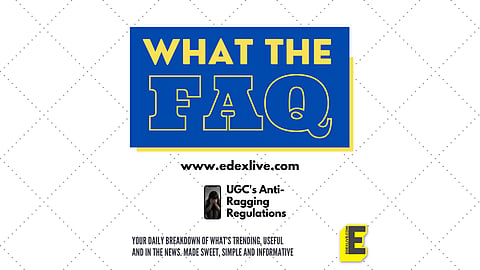

Back in April 2009, the University Grants Commission released a set of regulations to check the menace of ragging in educational institutions. With the recent incidents of deaths by suicide due to alleged ragging and harassment in educational institutions (KMC Warangal, IIT Bombay), we take a look at these regulations.
1. What do the UGC regulations propose to curb ragging?
The regulations state categorically that ragging in any form shall be completely banned in all educational institutions. Apart from this, educational institutions are required to adhere to the prevalent laws and criminal procedures with regard to ragging in their respective states, and under their respective statutory bodies. Students are to be sensitised and informed about the consequences of indulging in ragging before admission, through the institutions' prospectus, and after admissions through awareness programmes. Students and parents are also required to sign undertakings in this regard.
The regulations also propose the formation of Anti-Ragging Committees and Anti-Ragging Squads in educational institutions to monitor the students. The transfer certificates of students at the time of passing out must include a remark on their behavioural patterns so that institutions that enrol them, later on, can keep a watch on students with any problematic behaviours.
All cases of ragging brought to the notice of educational institutions must be reported and FIRs must be filed. Students who do not report cases of ragging either as witnesses or as victims must also be punished. Heads of institutions are required to submit weekly reports to the Vice-Chancellors of their respective universities for the first three months of a new academic year, and thereafter monthly reports for the rest of the year on the status of implementation of measures against ragging in the institution.
2. What punishments do the Regulations propose?
Punishments that institutions can mete out at their level can range from fines (upto Rs 1 lakh) and suspension, to rustication, cancellation of admission, expulsion and debarring from admission to other institutions. Universities, in case they find affiliated institutions violating regulations regarding ragging, can withdraw affiliation, withhold grants, and prohibit the issuance of degrees or diplomas to the students. Similar powers are granted to the UGC and other regulatory bodies.
2. What has the Supreme Court said about ragging in India?
In 2006, the Supreme Court directed the Ministry of Human Resource Development to form a committee to suggest measures to curb ragging. A seven-member panel headed by former CBI director Dr RK Raghavan was formed. This panel, in its report, recommended that a separate section be included in the Indian Penal Code for ragging. As per the recommendations of the panel, the Supreme Court made it mandatory for institutions to report all incidents of ragging as FIRs. The court added that all educational institutions are required to include previous incidents of ragging reported at their campuses in their prospectus or brochures.
3. Who was Aman Kachroo and what happened in 2009?
Aman Kachroo was a 19-year-old medical student in Himachal Pradesh who was ragged brutally by four seniors in 2009. Aman died as a result of injuries from the ragging, which led to a brain haemorrhage. The four seniors were convicted and sentenced to four years of rigorous imprisonment. However, they were released in 2013 on account of "good conduct" and were allowed to complete their medical degree. The national outrage following Aman's death resulted in the UGC's Anti-Ragging Regulations.
3. As per UGC data, how many cases of ragging were reported in recent times?
According to the UGC's anti-ragging cell, there were 511 cases of ragging reported in 2021. However, experts suggest that most cases go unreported. In February, two students died by suicide -- one at the Kakatiya Medical College in Warangal, Telangana and another at IIT Bombay. KMC's Dr D Preethi's family has alleged harassment from a senior student, whereas the family of IIT Bombay's Darshan Solanki has blamed institutional caste-based discrimination.
